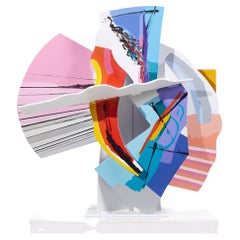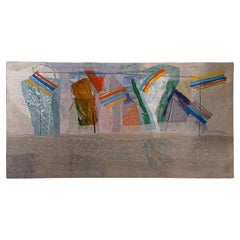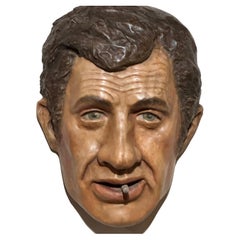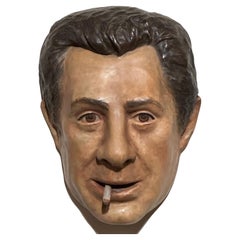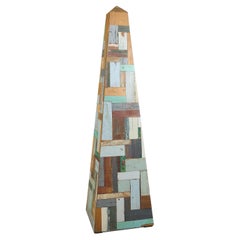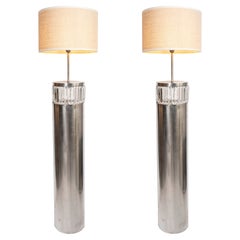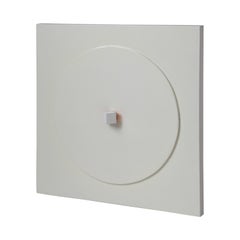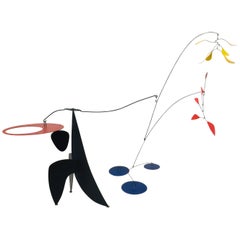Argentine Furniture
1
7
to
6
7
7
7
3
5
14
372
1,056
46
239
51
5
2
21
56
54
63
28
26
6
7
3
2
2
1
1
1,472
4,544
2,221
2,054
1,996
2
1
Period: 1990s
Place of Origin: Argentine
Shemi Post Modern Abstract Metal Sculpture
By Calman Shemi
Located in Countryside, IL
Shemi Post-Modern Abstract Metal Sculpture
This sculpture measures: 24 wide x 14 deep x 25 high
We take our photos in a controlled lighting studio to show as much detail as possibl...
Category
1990s Post-Modern Argentine Furniture
Materials
Metal
Calman Shemi First Light at Dawn Tapestry, 1990
By Calman Shemi
Located in Chicago, IL
Calman Shemi First Light at Dawn Tapestry, Signed 1990's. There is a slight water mark on upper right side.
Calman Shemi uses a great mix of colors, textures and shapes. He also deve...
Category
1990s Post-Modern Argentine Furniture
Materials
Natural Fiber, Paint
Original Hand Made Art Mask Jean-Paul Belmondo
Located in Oakland, CA
Original Hand Made Art Mask, a lifelike image of French actor Jean-Paul Belmondo. This mask is very dimensional with great artistic details and a natural...
Category
1990s Mid-Century Modern Argentine Furniture
Materials
Paint, Paper
Original Hand Made Art Mask Marcello Mastroianni
Located in Oakland, CA
Original Hand Made Art Mask, a lifelike image of Itallion actor Marcello Mastroianni. This mask is very dimensional with great artistic details an...
Category
1990s Mid-Century Modern Argentine Furniture
Materials
Paint, Paper
Patchwork Wood Obelisk
Located in Chicago, IL
New construction patchwork wood obelisk from a maker in Argentina.
Category
1990s Argentine Furniture
Materials
Wood
Pair of Chrome Iron and Crystal Floor Lamps, Argentina, 1990
Located in Buenos Aires, Buenos Aires
Pair of chrome iron and crystal floor lamps. Argentina, 1990.
Category
1990s Mid-Century Modern Argentine Furniture
Materials
Crystal, Chrome, Iron
Vintage Jesus Marcos Impetuous Violinist Oil Painting on Canvas
By Jesus Marcos
Located in Miami, FL
Vintage Jesus Marcos Impetuous Violinist oil painting on canvas
A native of Salamanca, Spain Marcos moved with his family to Argentina in 1960. He li...
Category
1990s Argentine Furniture
Materials
Canvas
Related Items
Contemporary Pair of Red Marble and Bronze Obelisks
Located in Toronto, ON
A pair of bronze & red marble obelisks embellished with tortoises made by a master bronze maker in Florence, Italy.
Category
2010s Argentine Furniture
Materials
Marble, Bronze
Massive Pop Art Wood Queen of Hearts
Located in Los Angeles, CA
Large Pop Art wood sculpture of a Queen of Hearst. Entire piece is made of wood. Super unique object. Great scale. Excellent vintage condition.
Category
1970s Vintage Argentine Furniture
Materials
Wood
Zodiac Copper Wall Art
Located in Antwerp, BE
Zodiac copper wall art.
Diameter:50 cm.
Depth:3 cm.
Category
Mid-20th Century Mid-Century Modern Argentine Furniture
Materials
Copper
Tapestry Royal Manufacture of Aubusson, Louis XVI period 1738 at the Gobelins
By Aubusson Manufacture
Located in Madrid, ES
Tapestry from the Royal Manufacture of Aubusson, Louis XVI period , made in 1738 at the Gobelins
One panel from a series of Gobelins tapestries depicting the History of Esther, illustrating Esther seated and attended by handmaidens, one washing her feet in golden basin, another fastening a bracelet, another offering a mirror, all observed by Mordecai, woven in the workshop of Michele Audran after a design by J. F. de Troy.
The Toilet of Esther c.1778-85.Royal Collection Trust-Queens Audience Chamber
Windsor Castle
The Sketches for the Esther Cycle by Jean-François de Troy (1736)
“and the maid was fair and beautiful; whom Mor’decai, ..., took for his own daughter.” (Est. 2:7)
A supple and undulating genius, both a flattering portraitist and a prolix history painter, as well as a brilliant genre painter, in a gallant or worldly vein, Jean-François de Troy (Paris, 1679 – Rome, 1752), solicited, although he had passed the threshold of old age, a new royal commission up to his ambitions. To obtain it, he submitted – successfully - for the approval of the Bâtiments du roi (administration), seven modelli painted in 1736 with his usual alacrity.
Inspired by one of the most novelistic texts of the Old Testament, the Book of Esther, these sketches in a rapid and virtuoso manner were transformed by the artist, between 1737 and 1740 into large cartoons intended to serve as models for the weavers of the Gobelins factory. Showing undeniable ease and skill in the composition in perfect harmony with the sensitivities of the times, the tapestry set met with great success.
The Story of Esther perfectly corresponded to the plan of the Bâtiments du roi to renew the repertoire of tapestry models used for the weavers of the royal factories while it also conformed to the tastes of Louis XV’s subjects for a fantastical Orient, the set for a dramatic tale in which splendour, love and death were combined. Indeed, no tapestry set was woven in France during the 18th century as often as that of Esther.
The series of modelli painted by de Troy during the year 1736 looks to the history of French painting and decoration under Louis XV as much as it does the history of the Gobelins. It probably counts among the most important rococo pictorial groups to have remained in private hands. First the Biblical source illustrated by De Troy which constitutes the base of one of the richest iconographical traditions of Western art will be considered. Then the circumstances and specific character of French civilisation during the reigns of Louis XIV and Louis XV which contributed to making the theme of Esther a relevant subject, both attractive to contemporaries and remarkably in line with the sensitivities of the time will be elucidated.
An examination of the exceptional series of sketches united here, the cartoons and the tapestries that they anticipate as well as a study of their reception will close this essay. The Book of Esther: A scriptural source at the source of rich iconography.
The origin of the Esther tapestry set by Jean-François de Troy – origin and creation of a masterpiece
According to the evidence of one of the artist’s early biographers, the chevalier de Valory, author of a posthumous elegy of the master, read at the Académie royale de peinture et de sculpture on 6 February 1762, it was apparently due to early16 rivalry with François Lemoyne (1688-1737), his younger colleague who had precisely just been appointed First Painter to the King in 1736, that had encouraged François de Troy to seek a commission allowing him to show off his ease and his promptitude at the expense of a rival who was notoriously laborious: “M. De Troy, retaining some resentment of the kind of disadvantage which he believed to have suffered compared with his emulator looked to regain some territory by making use of the facility his rival did not possess.
Lemoyne was excessively long in the creation of his works,and M. De Troy of a rare celerity: consequently, with this particular talent, the latter offered to the court to make paintings appropriate to be executed at the Gobelins Factory; and it is to this circumstance that we owe the beautiful series of the Story of Esther, which would be sufficient alone to give him a great reputation.”17 Beyond the suspicion inspired by the topos, which still constitutes, more or less, a tale of rivalries between artists in ancient literature, there is probably some truth in what Valory reports although A.-J. Dezalier d’Argenville (who indicates rather spitefully that de Troy did not hesitate to “cut prices” to impose himself, benefitting from the productivity assured by the unlikely rapidity of his brush)18 proves to be more evasive: “As he looked to busy himself, he had offered to make the paintings that serve as models for the King’s tapestries cheaply: which did not please his colleagues.
He was given a choice of two tapestry series to be made and he took the Story of Esther and that of Jason”.19 Whether or not the choice was actually left to de Troy (which would appear rather casual on the royal administration’s part all the same), it seems likely that the artist, whose contemporaries extol his “fire”, as the faculty of invention was then called, must have ardently aspired to the possibility of using on a very large scale the “creative genius” with which Dezallier d’Argenville credits him. The decoration of the private apartments, the fashion for which Louis XV had promoted at Versailles and Fontainebleau, offered little opportunity to excel in this area. Other than painting for altarpieces, only tapestries could allow comparison with Lemoyne who had been granted – unfortunately for him – a major decoration: the enormous ceiling of the Hercules Room at Versailles. Favoured by the recent improvement in France’s financial situation, the revival of patronage offered de Troy a commission fitting for him, in a field in which, however, he had hardly any experience.
Anxious to renew the repertoire of models available to the Gobelins factory, the Duc d’Antin, surintendant des Bâtiments du roi from 1708 to 1736 followed by his successor, Philibert Orry comte de Vignory, gave him the task of producing seven large cartoons inspired by the Book of Esther corresponding to the brilliant sketches or modelli which de Troy had produced in one go, or almost (very few preparatory drawings can in fact be linked to the Esther cycle and all seem to be at the execution stage of the cartoons).20 Subjected to the approval of the Administration des Bâtiments according to the procedure in use for projects being planned for the Gobelins, sketches made rapidly during 1736 were approved and the project launched immediately. Thereupon came the news of François Lemoyne’s death, who, ground down by work and a victim of his private torment, committed suicide on 4 June 1737.
Against all expectations, de Troy did not replace his rival in the position of First Painter (which remained vacant until the appointment of Charles Coypel in January 1747), which would perhaps have made him too obviously the beneficiary of the drama. The awarding of the position of Director of the French Academy in Rome came to console him while he had already produced (or he was in the process of finishing), in Paris, three of the seven cartoons of the cycle (The Fainting of Esther finished in 1737 and the Toilet and Coronation of Esther, both finished in 1738).
De Troy, we can see, did not follow the order of the narrative but began with the subjects which apparently offered the least difficulty because he had already depicted them, or because they fall into a strong pictorial tradition (such is the case especially for the Fainting of Esther). He had hardly settled at the Palazzo Mancini in August 1738, when his first task which awaited the new director of the French Academy naturally consisted of honouring the royal commission and finishing without delay the final cartoons of the Story of Esther after the sketches he must have taken with him. As prompt as ever, de Troy discharged himself of the execution of the four remaining cartoons in only two years, by beginning with the largest format which allowed him to strike the imagination and to impose himself as soon as he arrived on the Roman stage: the Triumph of Mor’decai which was finished in 1739 (like Esther’s Banquet).
The following year, the Mor’decai's Disdain and The Sentencing of Haman were brought to an end in the same Neo-Venetian style, obviously tributary to Veronese with its choice of “open” monumental architecture which is characteristic of the entire cycle.21 The series, it should be noted, was almost augmented with some additional scenes in the mid 1740s. Indeed, the first tapestry set finished at the Gobelins in 1744 proved to be unsuitable for the arrangement of the Dauphine’s apartments at Versailles for which it had been intended to decorate the walls the following year (cf infra). Informed of this, de Troy, considering that the story of Esther offered “several good subjects,” immediately offered to illustrate one or new subject among those “which could appear to be the most interesting”.
The directeur des Bâtiments Orry, who managed the State’s accounts, obviously judged it less costly to have one of the tapestries widened to fill in the end of the Dauphine’s bedroom,22 which has probably deprived us of very original compositions, because de Troy had already illustrated the most famous themes, those that benefitted from a strongly established iconographical tradition and from which it was not easy to deviate
The Tapestry Set of the Story of Esther
Placed on the tapestry looms of the Gobelins at the end of the 1730s in Michel Audran’s workshop, the cycle created by de Troy aroused true infatuation. The few hundred tapestries made between 1738 and 1797 – all in high-warp tapestry and woven in wool and silk except for four in low-warp made in Neilson’s workshop – show the impressive success of a tapestry set that was without any doubt the most frequently woven of the 18th century in France.
29 Only three cartoons had been delivered by de Troy in 1738 when the first tapestry set was begun by Audran under the expert eye of Jean-Baptiste Oudry to whom the Directeur général des bâtiments, Philibert Orry had assigned the (weekly) supervision of the weaving. During the summer of 1738, the piece of the Fainting of Esther, which Oudry judged to be admirable, was finished.
During the winter of 1742, Oudry informed Orry that about two ells of the Triumph of Mor’decai had been made “with no faults”,that the Coronation of Esther was finished and that the Esther at her Toilet “a very gracious tapestry” was “a little over half” finished. Exhibited at Versailles in 1743, these two last pieces were admired by Louis XV and the Court.
On 3 December 1744, the set of seven tapestries was finally delivered to the Garde Meuble. It was intended, the honour was not slight, to decorate the apartments of the Infanta Maria Teresa Rafaela of Spain whose marriage to the young Dauphin Louis-Ferdinand had been fixed for the following year (it took place on 23 February 1745). Apparently it was thought that the theme of Esther the biblical heroine and wife of a foreign sovereign was appropriate for the apartments of the Spanish Dauphine.
As early as the month of March, the architect Ange-Jacques Gabriel informed de Troy that her grand cabinet was decorated with the “Esther tapestry set” specifying however that “for lack of two small or one large piece, we have not been able to decorate the end of the room”. This difficulty led immediately to the Banquet episode being woven a second time in two parts (they were delivered to the Garde-Meuble on 30 December 1746) to garnish the panels on each side of the bed of the Dauphine who would hardly enjoy them (she died on 22 July 1746 and the decoration was installed for the new Dauphine Maria Josepha of Saxony).
The appearance of the set’s remarkable border, which imitated a richly sculpted wooden frame, should be mentioned. Conceived in 1738 by the ornamentalist Pierre Josse-Perrot and used in the later weavings until 1768, it tended to reinforce the resolutely painterly appearance of the tapestry set which, in this regard, pushed the art of tapestry as far as its ultimate mimetic possibilities. With the exception of Mor’decai's Disdain which had been removed earlier, the “editio princeps” of the story of Esther (from then on in nine pieces) remained at Versailles until the Revolution. Of the eight surviving tapestries, four are at the chateau of Compiègne and four belong today to the Mobilier National. No less than seven tapestry sets reputed to be complete (one of them in fact only had six tapestries) would be produced officially at the Gobelins up to 1772.
Literature:
1- The Œuvres mêlées of an emulator of Racine, the Abbé Augustin NADAL thus include an Esther. Divertissement spiritual which is exactly contemporary with Jean François de Troy’s cycle since it was performed in 1735 and published in Paris three years later.
2-Le Siècle de Louis XIV, 1751, 1785 ed., p. 96-97 for French ed.
3- Lemoyne and de Troy had been obliged to share the First Prize in the competition organised in 1727 between the most prominent history painters of the Académie Royale.
4- Mémoires…, pub. L. DUSSIEUX et al., 1854, II, p.265.
5-The fact that de Troy, at the risk of falling out with his colleagues, did not hesitate to make use of prices in order to convince the new directeur des Bâtiments Philibert Orry, is confirmed by Mariette who adds tersely “it caused much shouting” (pub. 1851-1860, II, p. 103).
6- Abrégé de la vie des plus fameux peintres…, ed. 1762, IV, p. 368-369 20 Early comments on the painter are inclined to present him as a kind of “pure painter”, doing without the medium of drawing, a few intermediary studies between the Esther sketches and the large cartoons at the Louvre nevertheless show that de Troy used red chalk (see in the catalogue, the notice for the Meal of Esther and Ahasuerus under the entry drawing) to change one or other figure.
7-C. GASTINEL-COURAL (cat. exp. PARIS, 1985, p. 9-13) as well as the article by J. VITTET, exh. cat. LA ROCHE-GUYON, 2001, p. 51-55.
8-The Hermitage in St. Petersburg conserves five tapestries of these two royal gifts whose provenance still awaits elucidation (as far as we are aware). In 1766, the Grand Marshal of Russia, Count Razumovski (or Razamowski), acquired the Fainting and the Banquet extracted from the sixth weaving (J. VITTET, 2001, p. 53).
9- Lettres écrites de Suisse, d’Italie…,quoted by J. VITTET, op. cit., p. 54.
10-The tapestry set remained in the hands of a branch of the Hapsburg-Lorraine family until 1933 (ibid. P. 54).
11-Quoted by Chr. LERIBAULT, 2002, p. 97, note 269.
12-Y. CANTAREL-BESSON, 1992, p. 241.
Catalogue
The Esther at her Toilet
Oil on canvas, 57 x 51 cm Provenance: Painted in 1736 at the same time as the six other modelli of the Story of Esther intended to be presented, for approval, to the direction des Bâtiments du Roi; perhaps identifiable among a lot of sketches by Jean-François de Troy in the post mortem inventory of the amateur, historian and critic Claude-Henri Watelet (1718-1786) drawn up on 13 January 1786 and following days (A.N. T 978, n° 30) then in the sale of the property of the deceased, Paris, 12 June 1786, n° 33; Paris, François Marcille Collection (who owned a series of six sketches from which the Triumph of Mor’decai was missing, see infra); Paris, Marcille Sale, Hôtel Drouot, 12-13 January 1857, n° 36; Asnières, Mme de Chavanne de Palmassy ( ?) collection; Paris, Galerie Cailleux; Paris, Humbert de Wendel collection (acquired from the Galerie Cailleux in 1928); by inheritance in the same family; Paris, Sotheby’s, 23 June 2011, n° 61. In order not to add unnecessarily to the technical commentary on each work, the catalogue raisonné by Chr. Leribault which contains a substantial bibliography on the series should be referred to. The other bibliographical references only concern the publications and exhibitions to have appeared and been presented more recently. Bibliography and Exhibitions: Chr. LERIBAULT, 2002, n° P. 247 (repr.); E. LIMARDO DATURI, 2004, p. 28; Exh. cat. NANTES, 2011, p. 138, n° 34, referred to in note 1; Sotheby’s catalogue, Tableaux anciens et du XIXe siècle, 23 June 2011, n° 61 (repr.).
Related Works:
Tapestry cartoon: The cartoon (oil on canvas, 329 x 320 cm), the third made by the artist in Paris after the sketches had been approved by the direction des Bâtiments, is in the Louvre (Inv. 8315). It previously bore the painter’s signature and the date 1738 (inscriptions which are found on the tapestries). The royal administration paid 1600 livres for it on 21 June 1738 and it was exhibited at the Salon in the year of its creation.
Summary Biography
1679 (27 January): Baptism in Paris (Parish of St. Nicolas du Chardonnet) of Jean-François de Troy, son of the painter François de Troy and Jeanne Cotelle, sister of the painter Jean II Cotelle.
1696-1698: Studies (apparently rather turbulent) at the Académie royale de peinture et de sculpture.
1698-1708: First trip to Italy. Is obliged to leave Rome in January 1711 after a tempestuous affair (a duel?), de Troy extends the traditional Roman experience as a pensionnaire at the Académie de France by also visiting Tuscany where he stays for a long time, Venice (his art in face has a strongly Venetian character) and Genoa.
1708: De Troy (whose father had been elected Director of the Académie royale de peinture et de sculpture on 7 July) is agréé and immediately received at the Académie with Apollo and Diana Piercing with their Arrows the Children of Niobe (Montpellier, Musée Fabre) on 28 July.
1710: First royal commission, paid for on 10 May (a sketch representing “the Promotion of the Order of the Holy Spirit” for the tapestry series of the History of the King).
1716: Jean-François de Troy is elected Assistant Professor at the Academy.
1720: He is appointed Professor.
1723: The artist creates the double portrait of Louis XV...
Category
Early 18th Century Baroque Antique Argentine Furniture
Materials
Silk, Wool
W 80.71 in L 124.02 in
Juan Miro Tapestry Labelled by Atelier Jules Pansu, France 1990.
By Jules Pansu, (after) Joan Miró
Located in Brussels, BE
Large rug or tapestry by Juan Miro " L'or de l'azur" edited by Atelier Jules Pansu.
Framed in a black wood box.
Labelled.
France around 1990.
Category
1990s Mid-Century Modern Argentine Furniture
Materials
Wool, Wood
Antique Tapestry Verdure Tapestry Large Handmade French Tapestry 5X7, 1900
Located in New York, NY
Antique Verdure Tapestry French Tapestry Handmade Antique Large Tapestry 1900
Measures: 5.4" x 7.4".
"A magnificent antique French tapestry depicting magnificent verdure and greenery. This piece includes rare black colors. Beautiful colorway, and an easy, chic addition to any space."-Antique Rug Collection
Size
5'4" x 7'3" 163cm x 221cm
Serial ID #
10095k
Design
Verdure
Origin
France
Age
circa 1900
Category
Antique
Pattern
Verdure/Floral/Human Figures
Material
100% Hand Woven Wool
Foundation Material
Cotton
Color
Beige, Green, Black, Brown, Pink, Ivory
Quality
Great
Condition
Great condition, minute low area
About Us~
Welcome to Antique Rug Collection. Your #1 Source for handmade Antique Rugs & Tapestries at great prices, curated by leading industry expert.
We are a 6th Generation antique rug shop with 48+ years of experience working with designers, private clients, dealers, and really anyone looking for a unique antique rug at a great price.
We've made an imprint selling rugs...
Category
Early 1900s Baroque Antique Argentine Furniture
Materials
Wool
H 64.18 in W 87.01 in D 0.3 in
Selenite Obelisk Pair
Located in New York, NY
Selenite Obelisk:
Each measures: 2.25" x 2.25" x 12" H.
Category
21st Century and Contemporary Argentine Furniture
Materials
Stone
Chrome and Linen Adjustable Floor Lamp by Nessen
By Walter Von Nessen, Nessen Studio
Located in Palm Springs, CA
A 1970s polish chrome with a vanilla linen shade adjustable floor lamp by Walter Von Nessen for Nessen Studios. The lamp has a swing arm and it raises up and down. Newly rewired.
D...
Category
1970s Modern Vintage Argentine Furniture
Materials
Chrome
Antique French Tapestry Antique Tapestry Handmade Tapestry Verdure Tapestry
Located in New York, NY
Rare Antique French Tapestry handmade Verdure Tapestry
4' x 5'
122cm x 153cm
Circa 1920
A magnificent antique French tapestry depicting a hunting scene amongst a verdure s...
Category
1920s Vintage Argentine Furniture
Materials
Wool
H 60.24 in W 48.04 in D 0.48 in
Ceramic Face Mask Wall Sculpture
By Asmaa Aman-Tran
Located in Stoughton, MA
A true embodiment of the Artist's style of combining different mediums, this wall sculpture echoes a festive moment in time, Drawing inspiration from the Artist's moroccan roots. This sculpture is an hommage to the talented women weavers of Morocco that the artist got to meet on her last weaving in retreat in Marrakech.
This wall hanging shaped out of hand wrapped manila rope using naturally dyed recycled silk yarn, sisal and. raffia. The ceramic face...
Category
2010s Tribal Argentine Furniture
Materials
Ceramic, Silk, Hemp, Raffia
Pair of Mid-Century Chrome Adjustable Pharmacy Floor Lamps
Located in Rio Vista, CA
Gorgeous pair of mid-century modern height adjustable pharmacy floor lamps featuring a thick nickel chrome finish. The weighted lamps adjust from 44 inches to an amazing 58 inches high with a swivel and tilt head. The light has an adjustable dimmer switch with a chrome hardware knob...
Category
20th Century Mid-Century Modern Argentine Furniture
Materials
Steel, Iron
Antique French Tapestry Handwoven French Tapestry Aubusson Verdure Tapestry
Located in New York, NY
Exceptional rare large antique French Tapestry handmade human animals "Mille Fleurs" Tapestry 6'8" x 8' (7' x 8') 203cm x 244cm Circa 1910
" An exce...
Category
1910s Vintage Argentine Furniture
Materials
Wool
H 96.07 in W 79.93 in D 0.3 in
Previously Available Items
Luis Tomasello Atmospera Chroma Plastica 921-A
By Luis Tomasello
Located in West Palm Beach, FL
A simple an elegant example incorporating a circle and cube.
orange highlights on underside of the cube.
Category
1990s Argentine Furniture
Materials
Wood
Extraordinary and Large Mobile or Stabile Sculpture
By Alexander Calder
Located in East Hampton, NY
Multicolored and the perfect balance of the 5 separate pieces mounted on a stabile base, makes this a wonderful moving sculpture. It is large and has a wide swing radius.
Category
1990s Mid-Century Modern Argentine Furniture
Materials
Metal
Pair of Large-Scale Lacquered Goatskin Lamps
By Lorin Marsh
Located in Atlanta, GA
Pair of large-scale lacquered goatskin lamps, circa 1990s. These lamps were originally retailed through Lorin Marsh. They appear to be constructed of lacquered goatskin over resin wi...
Category
1990s Mid-Century Modern Argentine Furniture
Materials
Brass
Mule Deer Horns and Skull
Located in Chicago, IL
Huge Mule Deer horns and skull mounted with a plaque stating El Retablo. Harvested in 1995 in Argentina and expertly mounted by the finest taxidermist Anima...
Category
1990s Argentine Furniture
Materials
Horn
Jesus Marcos Argentine Painting Titled "Mesa Con Objetos"
By Jesus Marcos
Located in Miami, FL
Jesus Marcos Argentine Painting Titled "Mesa Con Objetos"
An abstract still life oil on canvas painting by artist Jesus Marcos (Argentina) signed ...
Category
1990s Modern Argentine Furniture
Materials
Canvas
Contemporary Painting by Argentinian Artist Hugo Oldach
By Hugo Oldach
Located in Miami, FL
A still life acrylic on canvas painting by renowned Argentinian artist Hugo Oldach (b.1954). A still life depicting a bowl of peaches. Nicely framed in a natural colored wood frame w...
Category
1990s Modern Argentine Furniture
Materials
Acrylic, Canvas
Monumental Argentinian Algarrobo Wood Trestle Table and Ten Chairs
By Larry Pearson, Arte Etnico, Ricardo Paz
Located in Los Angeles, CA
Expansive, great proportioned three plank trestle table and ten chairs made from Algarrobo wood from Argentina, designed by Larry Pearson and Ricardo Paz for Arte Etnico. This set was featured in the book "Rustic Home" by Ralph Kylloe, which is also included in the sale. The table is accompanied by two armchairs and eight side chairs with woven leather seats.
This table is ideal for a large dining or conference room. Other prominent uses would be at a restaurant or hotel as a communal dining...
Category
1990s Rustic Argentine Furniture
Materials
Cane, Wood
Recently Viewed
View AllMore Ways To Browse
Bedside Chest Pair
Bedside Chests Pair
Cabinet On Stand Oak
Wooden Vintage Cabinet
Carved Shell Cabinet
Chinese Walnut
Blue French Cabinet
Black Accent Cabinets
White Chest Of Drawers Brass
Walnut Inlay Commode
Italian Black Showcase
White Commode With Marble
Asian Cabinet With Drawers
Vintage Metal Door
Vintage Metal Doors
White Marble Top Chest
Asian China Cabinet
Brass Glass Shelves Display
